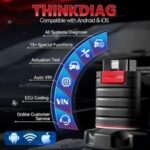Delving into your vehicle’s data can unlock a deeper understanding of its operation. The On-Board Diagnostics II (OBD2) system, standard in most modern cars, provides a wealth of information, including real-time engine speed, or RPM. By connecting an Arduino to your car’s OBD2 port, you can access this data and create custom displays, logging systems, or even integrate it into larger DIY automotive projects. However, it’s crucial to proceed with caution when interacting with your vehicle’s network. Incorrect connections or code could potentially lead to unexpected behavior or even damage. Always begin experimentation with your vehicle safely parked and ensure you understand the basics before proceeding. If you are unsure about any step, it might be best to explore pre-made OBD2 Bluetooth scanners instead of directly interfacing with the CAN bus.
The backbone of modern vehicle communication is the Controller Area Network, or CAN bus. Think of it as your car’s internal network, similar in concept to your home’s LAN or WiFi. Instead of countless individual wires running between every sensor and control unit, the CAN bus allows all these components to communicate digitally over a shared two-wire system. This sophisticated network simplifies wiring and enables complex data exchange throughout the vehicle. You’ll access this network via the OBD2 port, a standardized connector typically located under your dashboard. While a deep dive into the intricacies of CAN bus protocol isn’t strictly necessary for this project, a fundamental understanding of its role in vehicle communication is beneficial for troubleshooting and modifying Arduino code effectively.
For vehicles manufactured after 2008 in the United States, the communication standard is often ISO 15765 CAN bus, which is suitable for this type of Arduino project. Before you begin, verify that your car utilizes a CAN bus system. While most cars have the same physical OBD2 port connector, the communication protocols can vary between manufacturers. Remember that each vehicle is unique. Factors like CAN bus speed, specific OBD2 Parameter IDs (PIDs) for RPM, and other vehicle-specific characteristics will require attention and may need adjustments in your Arduino code. Researching your specific car model’s OBD2 implementation is a vital step in ensuring a successful project and avoiding potential issues.
